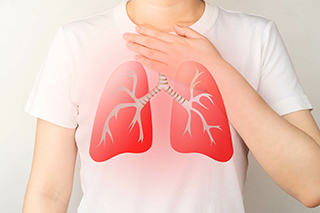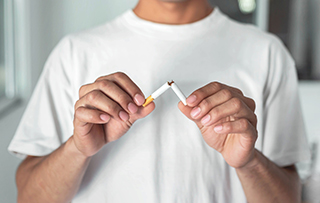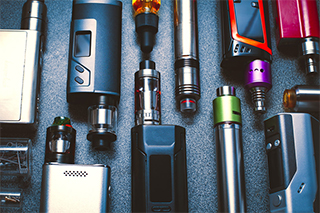Introduction

The smoke from the tobacco in conventional cigarettes and the vapor produced by electronic cigarettes both contain thousands of chemicals, of which many are hazardous to our health.
The link between smoking and disease, particularly lung cancer and cardiovascular disease, is well understood. Cigarette smoking remains the leading cause of preventable death in the United States.
E-cigarettes initially resembled traditional cigarettes and were introduced as a smoking cessation tool for people who smoked cigarettes made with tobacco. Their appearance and use has changed over the past two decades. Under an umbrella term of “electronic nicotine delivery systems (ENDS),” products referred to here as e-cigarettes may also be called vapes, vaporizers, vape pens, hookah pens, e-cigs, e-cigars, and e-pipes.
The 2021 National Youth Tobacco Survey found that more than 2 million middle and high school kids used e-cigarettes, and most used a flavored product. There is public health concern about the popularity of e-cigarette products, especially the flavored variety with kids.
Cigarettes

Over the decades, NIEHS researchers have identified many ways that cigarette smoke negatively affects health. Some findings follow.
Asthma. Cigarette smoke contains formaldehyde, lead, tar, nicotine, and other chemicals, many of which act as irritants and worsen symptoms in people with asthma and allergies. Studies have found that smoking decreases the effectiveness of inhalers used to treat asthma.1
Autoimmune diseases are caused by the body’s immune system attacking healthy cells. Studies have shown cigarette smoke to be a risk factor in the development of rheumatoid arthritis, an autoimmune disease that affects joints.2
Male fertility. NIEHS-funded researchers discovered cigarette smoking is linked to sperm abnormalities that may limit men’s fertility. They found smokers had lower sperm volume and total sperm count.3
Maternal smoking and children. Studies have shown that there is no safe level or safe trimester for maternal smoking during pregnancy.4 Maternal smoking has also been associated with childhood obesity and preterm birth.5
E-Cigarettes
A Short History of E-Cigarettes

2006: When e-cigarettes first appeared in the U.S., they resembled cigarettes and were primarily used as a tool for people who wanted to quit smoking.
2010: Developers started modifying vaping liquid to add flavors, such as fruit and mint. Bigger batteries and settings gave users control over the heating coil, allowing them to alter the amount of aerosol delivered.
2015: New devices reduced the larger vaporizers to small devices that resembled a USB drive. The chemistry of the liquid was also changed, allowing the concentration of nicotine to double.
2016: The U.S. Food and Drug Administration (FDA) began to regulate e-cigarettes as new tobacco products. The market was soon flooded with disposable devices that came in many flavors, shapes, and colors that were attractive to young people.
2019: An outbreak of EVALI (E-cigarette, or Vaping Product, Use Associated Lung Injury), a severe and potentially lethal lung disease, led to 2,807 hospitalizations and 68 deaths. The outbreak was eventually attributed to a chemical added to some vaping devices.
2020: FDA issued a partial ban on some flavors because of their appeal to youth.
How They Work
E-cigarette work by heating a liquid, which typically contains nicotine, to generate an aerosol or vapor that users inhale. This is commonly known as vaping. Vaping owes its popularity, particularly among teens and young adults, to easy availability, targeted marketing, and creative flavors.
Are They Safe?
Over the years, the safety of e-cigarettes has been called into question.6 While an understanding of the health effects of vaping remains incomplete,7 studies have shown that e-cigarettes may harm human health.8 For example, studies associate e-cigarette use with asthma and COPD.9 Other studies linked vaping with cardiopulmonary illnesses.10
Smoking, Vaping, and COVID-19
The evidence supports a role for both e-cigarettes and cigarette smoking in increasing the risk of hospital admission, disease severity, and death related to COVID-19.11 A study of college students showed that dual use of nicotine products — e-cigarettes and conventional cigarettes together — increased COVID-19-related risks.12
Toxic metal exposure, from tobacco smoke and elsewhere, may also be considered a potential risk factor for COVID-19 severity.13
Smoking status and intensity of smoking were associated with hospitalizations and ICU admission in patients with COVID-19.14 Smokers with COVID-19 are more likely to require ventilation, have a major cardiovascular event, or to die, regardless of their sociodemographic or medical history.15 Men who smoke are more likely to die from COVID-19 than women.16
-
Polosa R, Thomson NC. 2013. Smoking and asthma: dangerous liaisons. Eur Respir J 41(3):716-726. [Abstract Polosa R, Thomson NC. 2013. Smoking and asthma: dangerous liaisons. Eur Respir J 41(3):716-726.]
-
Chang K, Yang SM, Kim SH, Han KH, Park SJ, Shin JI. 2014. Smoking and rheumatoid arthritis. Int J Mol Sci 15(12):22279-22295. [Abstract Chang K, Yang SM, Kim SH, Han KH, Park SJ, Shin JI. 2014. Smoking and rheumatoid arthritis. Int J Mol Sci 15(12):22279-22295.]
-
Tang Q, Pan F, Wu X, Nichols CE, Wang X, Xia Y, London SJ, Wu W. 2019. Semen quality and cigarette smoking in a cohort of healthy fertile men. Environ Epidem 3(4):e055. [Abstract Tang Q, Pan F, Wu X, Nichols CE, Wang X, Xia Y, London SJ, Wu W. 2019. Semen quality and cigarette smoking in a cohort of healthy fertile men. Environ Epidem 3(4):e055.]
-
Liu B, Xu G, Sun Y, Qiu X, Ryckman KK, Yu Y, Snetselaar LG, Bao W. 2020. Maternal cigarette smoking before and during pregnancy and the risk of preterm birth: A dose-response analysis of 25 million mother-infant pairs. PLoS Med. 17(8):e1003158. [Abstract Liu B, Xu G, Sun Y, Qiu X, Ryckman KK, Yu Y, Snetselaar LG, Bao W. 2020. Maternal cigarette smoking before and during pregnancy and the risk of preterm birth: A dose-response analysis of 25 million mother-infant pairs. PLoS Med. 17(8):e1003158.]
-
VVrijheid M, Fossati S, Maitre L, Márquez S, Roumeliotaki T, Agier L, Andrusaityte S, Cadiou S, Casas M, de Castro M, Dedele A, Donaire-Gonzalez D, Grazuleviciene R, Haug LS, McEachan R, Meltzer HM, Papadopouplou E, Robinson O, Sakhi AK, Siroux V, Sunyer J, Schwarze PE, Tamayo-Uria I, Urquiza J, Vafeiadi M, Valentin A, Warembourg C, Wright J, Nieuwenhuijsen MJ, Thomsen C, Basagaña X, Slama R, Chatzi L. 2020. Early-life environmental exposures and childhood obesity: An exposome-wide approach. Environ Health Perspect. Jun;128(6):67009. [Abstract VVrijheid M, Fossati S, Maitre L, Márquez S, Roumeliotaki T, Agier L, Andrusaityte S, Cadiou S, Casas M, de Castro M, Dedele A, Donaire-Gonzalez D, Grazuleviciene R, Haug LS, McEachan R, Meltzer HM, Papadopouplou E, Robinson O, Sakhi AK, Siroux V, Sunyer J, Schwarze PE, Tamayo-Uria I, Urquiza J, Vafeiadi M, Valentin A, Warembourg C, Wright J, Nieuwenhuijsen MJ, Thomsen C, Basagaña X, Slama R, Chatzi L. 2020. Early-life environmental exposures and childhood obesity: An exposome-wide approach. Environ Health Perspect. Jun;128(6):67009.]
-
Gordon T, Karey E, Rebuli ME, Escobar YH, Jaspers I, Chen LC. 2022. E-cigarette toxicology. Annual Review of Pharmacology and Toxicology. 62:1, 301-322. [Abstract Gordon T, Karey E, Rebuli ME, Escobar YH, Jaspers I, Chen LC. 2022. E-cigarette toxicology. Annual Review of Pharmacology and Toxicology. 62:1, 301-322.]
-
Bonner E, Chang Y, Christie E, Colvin V, Cunningham B, Elson D, Ghetu C, Huizenga J, Hutton SJ, Kolluri SK, Maggio S, Moran I, Parker B, Rericha Y, Rivera BN, Samon S, Schwichtenberg T, Shankar P, Simonich MT, Wilson LB, Tanguay RL. 2021. The chemistry and toxicology of vaping. Pharmacol Ther. 225:107837. [Abstract Bonner E, Chang Y, Christie E, Colvin V, Cunningham B, Elson D, Ghetu C, Huizenga J, Hutton SJ, Kolluri SK, Maggio S, Moran I, Parker B, Rericha Y, Rivera BN, Samon S, Schwichtenberg T, Shankar P, Simonich MT, Wilson LB, Tanguay RL. 2021. The chemistry and toxicology of vaping. Pharmacol Ther. 225:107837.]
-
Tehrani MW, Newmeyer MN, Rule AM, Prasse C. 2021. Characterizing the chemical landscape in commercial e-cigarette liquids and aerosols by liquid chromatography-high-resolution mass spectrometry. Chem Res Toxicol. 34(10):2216-2226. [Abstract Tehrani MW, Newmeyer MN, Rule AM, Prasse C. 2021. Characterizing the chemical landscape in commercial e-cigarette liquids and aerosols by liquid chromatography-high-resolution mass spectrometry. Chem Res Toxicol. 34(10):2216-2226.]
-
Wills TA, Soneji SS, Choi K, Jaspers I, Tam EK. 2021. E-cigarette use and respiratory disorders: an integrative review of converging evidence from epidemiological and laboratory studies. Eur Respir J. 57(1):1901815. [Abstract Wills TA, Soneji SS, Choi K, Jaspers I, Tam EK. 2021. E-cigarette use and respiratory disorders: an integrative review of converging evidence from epidemiological and laboratory studies. Eur Respir J. 57(1):1901815.]
-
Gordon T, Karey E, Rebuli ME, Escobar YH, Jaspers I, Chen LC. 2022. E-cigarette toxicology. Annual Review of Pharmacology and Toxicology. 62:1, 301-322. [Abstract Gordon T, Karey E, Rebuli ME, Escobar YH, Jaspers I, Chen LC. 2022. E-cigarette toxicology. Annual Review of Pharmacology and Toxicology. 62:1, 301-322.]
-
Benowitz NL, Goniewicz ML, Halpern-Felsher B, Krishnan-Sarin S, Ling PM, O'Connor RJ, Pentz MA, Robertson RM, Bhatnagar A. 2022. Tobacco product use and the risks of SARS-CoV-2 infection and COVID-19: current understanding and recommendations for future research. Lancet Respir Med. 10(9):900-915. [Abstract Benowitz NL, Goniewicz ML, Halpern-Felsher B, Krishnan-Sarin S, Ling PM, O'Connor RJ, Pentz MA, Robertson RM, Bhatnagar A. 2022. Tobacco product use and the risks of SARS-CoV-2 infection and COVID-19: current understanding and recommendations for future research. Lancet Respir Med. 10(9):900-915.]
-
Merianos AL, Russell AM, Mahabee-Gittens EM, Barry AE, Yang M, Lin HC. 2022. Assessment of exclusive, dual, and polytobacco e-cigarette use and COVID-19 outcomes among college students. Am J Health Promot. 36(3):421-428. [Abstract Merianos AL, Russell AM, Mahabee-Gittens EM, Barry AE, Yang M, Lin HC. 2022. Assessment of exclusive, dual, and polytobacco e-cigarette use and COVID-19 outcomes among college students. Am J Health Promot. 36(3):421-428.]
-
Skalny AV, Lima TRR, Ke T, Zhou JC, Bornhorst J, Alekseenko SI, Aaseth J, Anesti O, Sarigiannis DA, Tsatsakis A, Aschner M, Tinkov AA. 2020. Toxic metal exposure as a possible risk factor for COVID-19 and other respiratory infectious diseases. Food and Chemical Toxicology, Volume 146, 111809, ISSN 0278-6915. [Abstract Skalny AV, Lima TRR, Ke T, Zhou JC, Bornhorst J, Alekseenko SI, Aaseth J, Anesti O, Sarigiannis DA, Tsatsakis A, Aschner M, Tinkov AA. 2020. Toxic metal exposure as a possible risk factor for COVID-19 and other respiratory infectious diseases. Food and Chemical Toxicology, Volume 146, 111809, ISSN 0278-6915.]
-
Mahabee-Gittens EM, Mendy A, Merianos AL. 2021. Assessment of severe COVID-19 outcomes using measures of smoking status and smoking intensity. Int J Environ Res Public Health. 18(17):8939. [Abstract Mahabee-Gittens EM, Mendy A, Merianos AL. 2021. Assessment of severe COVID-19 outcomes using measures of smoking status and smoking intensity. Int J Environ Res Public Health. 18(17):8939.]
-
Poudel R, Daniels LB, DeFilippis AP, Hamburg NM, Khan Y, Keith RJ, Kumar RS, Strokes AC, Robertson RM, Bhatnagar A. 2022. Smoking is associated with increased risk of cardiovascular events, disease severity, and mortality among patients hospitalized for SARS-CoV-2 infections. PLoS One. 17(7):e0270763. [Abstract Poudel R, Daniels LB, DeFilippis AP, Hamburg NM, Khan Y, Keith RJ, Kumar RS, Strokes AC, Robertson RM, Bhatnagar A. 2022. Smoking is associated with increased risk of cardiovascular events, disease severity, and mortality among patients hospitalized for SARS-CoV-2 infections. PLoS One. 17(7):e0270763.]
-
Khalil A, Dhingra R, Al-Mulki J, Hassoun M, Alexis N. 2021. Questioning the sex-specific differences in the association of smoking on the survival rate of hospitalized COVID-19 patients. PLoS One. 16(8):e0255692. [Abstract Khalil A, Dhingra R, Al-Mulki J, Hassoun M, Alexis N. 2021. Questioning the sex-specific differences in the association of smoking on the survival rate of hospitalized COVID-19 patients. PLoS One. 16(8):e0255692.]
What is NIEHS Doing?
NIEHS scientists are conducting the E-Cigs and Smoking Study, to develop new biomarkers, or indicators of what is normal or abnormal in our bodies, for both tobacco smoke exposure and e-cigarette use.
Toxic Metals
Another NIEHS-funded study, Exposure to Metals from E-Cigarettes (EMIT), has shown that e-cigarettes expose users to toxic metals such as arsenic and lead. A related study showed that exposure to ethyl maltol and copper in e-cigarettes caused the cells that line the surface of the lungs to die.17
Other studies have shown that e-cigarettes are potential sources of exposure to chromium, nickel, manganese and zinc.18 These and other metals are particularly toxic to the heart and vascular system.19 This “neurotoxicity” can result in inflammation and impair cells’ ability to rid themselves of toxins, called oxidative stress.20 Most metal levels found in the tissue of e-cigarette users were similar or higher than levels of the same metals found in users of conventional cigarettes.21
A 2023 study measured and compared metal aerosol concentrations by device type and common flavors. Metals and metalloids measured included: aluminum, arsenic, cobalt, chromium, copper, iron, manganese, nickel, lead, antimony, tin, and zinc. The study revealed wide variability in aerosol metal concentrations among different e-cigarette device types, brands, and flavors. Tobacco-flavored aerosols contained the highest metal concentrations. Metal concentration differences among types of devices appears to be related to the coil composition or power within the device.
NIEHS and E-Cigarette Education
NIEHS and the University of North Carolina at Chapel Hill Center for Public Engagement with Science are bringing the science of e-cigarettes and other environmental health topics to the most likely demographic to take up using the products: K-12 students.
The NIEHS-funded Environmental Health Sciences Center at the University of Rochester developed a learning kit for students called “Are Flavored E-cigarettes Harmful?” The lesson demonstrates how flavor compounds affect lung cells. The kit is based on published research studies from the laboratory of Irfan Rahman, Ph.D., who investigates the health effects of flavoring chemicals.
-
Durrani K, El Din SA, Sun Y, Rule AM, Bressler J. 2021. Ethyl maltol enhances copper mediated cytotoxicity in lung epithelial cells. Toxicol Appl Pharmacol. Jan 1;410:115354. [Abstract Durrani K, El Din SA, Sun Y, Rule AM, Bressler J. 2021. Ethyl maltol enhances copper mediated cytotoxicity in lung epithelial cells. Toxicol Appl Pharmacol. Jan 1;410:115354.]
-
Olmedo P, Goessler W, Tanda S, Grau-Perez M, Jarmul S, Aherrera A, Chen R, Hilpert M, Cohen JE, Navas-Acien A, Rule AM. 2018. Metal concentrations in e-cigarette liquid and aerosol samples: The contribution of metallic coils. Environmental Health Perspectives 126:2 CID: 027010. [Abstract Olmedo P, Goessler W, Tanda S, Grau-Perez M, Jarmul S, Aherrera A, Chen R, Hilpert M, Cohen JE, Navas-Acien A, Rule AM. 2018. Metal concentrations in e-cigarette liquid and aerosol samples: The contribution of metallic coils. Environmental Health Perspectives 126:2 CID: 027010.] [Full Text Olmedo P, Goessler W, Tanda S, Grau-Perez M, Jarmul S, Aherrera A, Chen R, Hilpert M, Cohen JE, Navas-Acien A, Rule AM. 2018. Metal concentrations in e-cigarette liquid and aerosol samples: The contribution of metallic coils. Environmental Health Perspectives 126:2 CID: 027010.]
-
Navas-Acien A, Martinez-Morata I, Hilpert M, Rule A, Shimbo D, LoIacono NJ. 2020. Early cardiovascular risk in e-cigarette users: The potential role of metals. Curr Environ Health Rep. 7(4):353-361. [Abstract Navas-Acien A, Martinez-Morata I, Hilpert M, Rule A, Shimbo D, LoIacono NJ. 2020. Early cardiovascular risk in e-cigarette users: The potential role of metals. Curr Environ Health Rep. 7(4):353-361.]
-
Ruszkiewicz JA, Zhang Z, Gonçalves FM, Tizabi Y, Zelikoff JT, Aschner M. 2020. Neurotoxicity of e-cigarettes. Food Chem Toxicol. 138:111245. [Abstract Ruszkiewicz JA, Zhang Z, Gonçalves FM, Tizabi Y, Zelikoff JT, Aschner M. 2020. Neurotoxicity of e-cigarettes. Food Chem Toxicol. 138:111245.]
-
Zhao D, Aravindakshan A, Hilpert M, Olmedo P, Rule AM, Navas-Acien A, Aherrera A. 2020. Metal/metalloid levels in electronic cigarette liquids, aerosols, and human biosamples: A systematic review. Environmental Health Perspectives 128:3. [Abstract Zhao D, Aravindakshan A, Hilpert M, Olmedo P, Rule AM, Navas-Acien A, Aherrera A. 2020. Metal/metalloid levels in electronic cigarette liquids, aerosols, and human biosamples: A systematic review. Environmental Health Perspectives 128:3.]
Further Reading
Stories from the Environmental Factor (NIEHS Newsletter)
- Vaping’s respiratory effects traced by leading basic researcher (April 2023)
- E-cigarettes Expose Users to Toxic Metals Such As Arsenic, Lead (February 2022)
Additional Resources
- Facts on E-Cigarette Use Among Youth and Young Adults – Information from the U.S. Surgeon General
- E-Cigarettes, Vapes, and other Electronic Nicotine Delivery Systems – Information from the Food and Drug Administration
- Secondhand Smoke: Questions and Answers – Information from the National Cancer Institute
- Secondhand Smoke and Smoke-free Homes – Information from the U.S. Environmental Protection Agency
- Smoking and Tobacco Use – Information from the Centers for Disease Control and Prevention
Related Health Topics
This content is available to use on your website.
Please visit NIEHS Syndication to get started.

